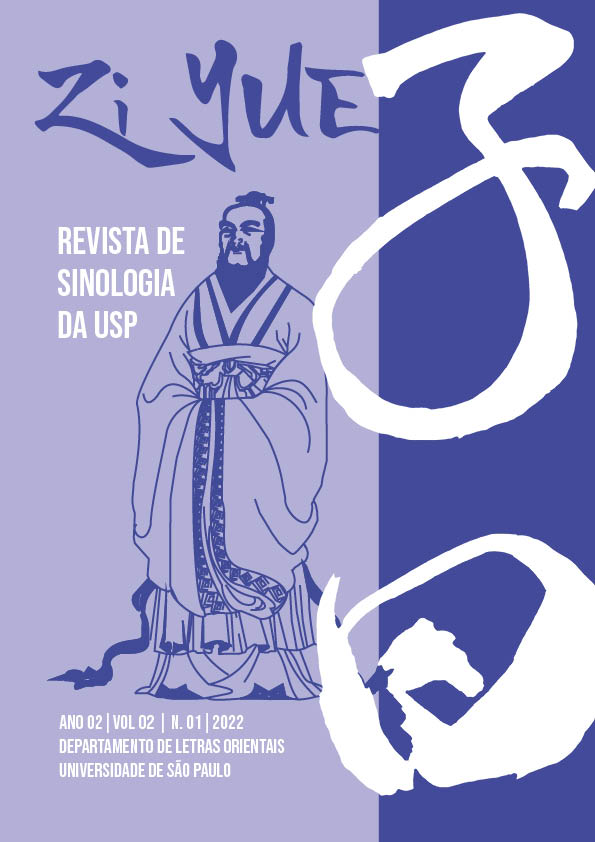Understanding Chinese Landscape Painting
DOI:
https://doi.org/10.11606/issn.2675-4614.v2i01p22-42Keywords:
Chinese painting, Landscape, Materials, TechniquesAbstract
Having in mind promoting the understanding of traditional Chinese painting - especially landscape painting - I try to describe its material, technique, and philosophical aspects. I begin precisely with the misunderstanding that it has been a victim of since the days of the first Christian missionaries in China. I point out the materials related to it, from mediums to supports, and list the most important brushstrokes that are part of its basic vocabulary. Next, I look at the six major fundamental precepts for the execution and appreciation of Chinese landscape painting. I then proceed to analyse the main features of an artwork of Chinese landscape painting, starting with the importance of empty space and the intimately associated game of yin and yang, followed by insipidity, fluency, non-linear perspective, and refusal of mimesis. Finally, I outline a brief tour of the history of Chinese painting, not only landscape painting but other genres as well, highlighting the diversity and the kind of creativity that is at play.Downloads
References
CERVERA Isabel., El arte chino. I Y II, Historia 16, Madrid, 1989 y 1992.
CERVERA Isabel. Mi Fu. In: El Paseante. Madrid, Número 20-22, p. 93, 1993.
CERVERA Isabel., Zhu Da. In El Paseante. Madrid, Número 20-22, pp. 102-103,1993.
CHENG, François. Vide et plein: Le langage pictorial chinois. Paris: Seuil, 1979.
CHENG, Anne. Zhuang Zi à l’écute du Dào e Le Dào du non-agir dans le Lao Zi. In: Histoire de la Pensée. Paris: Seuil, pp.113-267, 1997.
Dao De Jing. Mem-Martins: Europa-América, 2002.
DUBROVSKAYA, Dinara V. Exception to the rule: how adaptation genius. Matteo Ricci failed to understand Chinese painting. In: Journal of the Institute of Oriental Studies RAS, Moscovo, nº 4, pp. 126-135, 2020.
FARRER, Anne. Calligraphy and Painting for Official Life. In: RAWSON, Jessica (ed.) The British Book of Chinese Art. London: British Museum, pp. 84-133, 2007.
HUI Juan e JIA Xiaoqing. The Translation Strategies of “Wrinkle” in Chinese Landscape Painting. In: Sino-US English Teaching, Vol. 16, No. 4, 168-171, April 2019
JULLIEN, François. Éloge de la fadeur. Á partir de la pensée et de l´esthetique de la Chine. Paris: Éditions Philippe Picquier, 1991.
JULLIEN, François. La grande image n’ a pas de forme. Paris: Seuil, 2003.
KESWICK, Maggie. The Painter’s Eye. In: The Chinese Garden. London: Academy Editions, pp. 91-115, 1986.
LOPEZ, António José Mezcua. El Concepto de Paisage en China. Granada: Universidade de Granada. Tese de Doutoramento. 2007 http://paisajeyterritorio.es/assets/el-concepto-de-paisaje-en-china.-mezcua-lopez%2C-a.pdf
PANG, Mae Anna. Zhu Da: The Mad Monk Painter. In: Art Journal 25, Melbourne: 25 Jun 2014. https://www.ngv.vic.gov.au/essay/zhu-da-the-mad-monk-painter/
ROY, Claude. A China ontem e hoje. Porto: Editorial Inova, pp. 79-80, s/d.
RYCKMANS P., Poesía y pintura. In: El Paseante. Madrid, Número 20-22, pp.130-143, 1993.
SHITAO. A Pincelada Única, Guimarães: Pedra Formosa, 2001.
SÍREN, Oswald. The Chinese on the Art of Painting. Texts by the Painter-Critics, from the Han through the Ch’ing Dynasties. New York: Dover Publications, (1936) 2005.
WANG, Robin R. Yinyang. The Way of Heaven and Earth in Chinese Thought and Culture. Estados Unidos: Cambridge University Press, 2012.
WAY, Der-Lor. The Synthesis of Rock Textures in Chinese Landscape Painting, Taiwan: National Chiao-Tung University. Tese de Mestrado, 2001.
WILLIES, Ben. The Tao of Art. The Inner Meaning of Chinese Art and Philosophy. Bloomington: iUniverse, 1987.
Downloads
Published
Issue
Section
License
Copyright (c) 2022 Claudia Ribeiro Ribeiro

This work is licensed under a Creative Commons Attribution-NonCommercial 4.0 International License.



